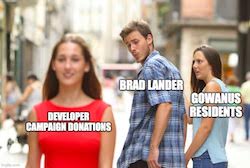Riverkeeper, New York's clean water advocate, was out last Friday, November 2nd, to sample the waters after Hurricane Sandy. They just published the results of these tests. They show that the Gowanus Canal had the highest sewage level by far. Though we all know that Combines Sewer Overflow is dumped into the canal during heavy rains, it is important to note that Hurricane Sandy, though destructive, was not significant rain event. In comparison to the Gowanus findings after the storm, even Newtown Creek's numbers came in fairly low.
Riverkeeper will be out again on Friday, November 9th to take additional samples.
four days after Superstorm Sandy
Last Friday, Riverkeeper conducted our first patrol of New York Harbor since Sandy. The water quality conditions "looked" really good, better than average, at all sample sites except the Gowanus Canal. There, the water was grey and opaque, which is often the case when high levels of sewage contamination are present.
| A Combined Sewer Overflow (CSO) discharge pipe next to our sampling site in the Gowanus Canal |
Sewage contamination levels at 6 of our standard sampling sites on 11/2/12
When compared to our historic sampling data for these same locations it’s pretty clear that although we expect that combined sewer overflows (CSOs) were discharging, the extra volume from storm flooding (dilution) resulted in temporarily lower sewage concentrations than we have often observed at these locations, especially after storms. We measure much worse regional contamination during run-of-the-mill summer rainstorms than we found after Sandy.
Historic contamination levels at these sites 2006 – 2011
The three very high tides which occurred during the storm (Monday morning through Tuesday midday) brought unimaginable amounts of clean sea water into New York Harbor and appear to have “flushed” the entire harbor, including the sewage contamination released by CSOs and any pump station and sewer plant failures that occurred. The extreme contamination in the Gowanus Canal is probably due to additional, perhaps ongoing, sewage discharges from CSOs or bypasses into the Canal continuing after the tidal flooding ended.
Riverkeeper is also concerned about the chemical, petroleum and floatable pollution (such as plastics) that undoubtedly entered the river, harbor and ocean as a result of the tidal flooding and subsequent “flush.”
Learn more about Riverkeeper’s Water Quality Program:
- View other monthly water quality reports, June 2010 to present.
- View historic sampling data sorted historically by individual sampling location.








.JPG)

5 comments:
Excellent information for the community to know and be aware of, Katia. Thanks for posting this.
I walk over the canal regularly but yesterday the smell was SO bad I wanted to vomit. Really, really bad, much worse than usual.
Has anyone had their home or business itself tested for air quality issues? After at least 3 hours of being bounced around the EPA phone lines and back again to the Dept of Health no one can tell me how to ENSURE that my home is safe to inhabit. We have small children who I'm am terrified to expose to toxic vapors and Lord knows what else. I called the EPA and emailed and advised that according to www.bradlander.com :As you may know, Councilmember Lander has been in communication with EPA Region 2 Administrator Judith Enck and NYC Department of Environmental Protection Commissioner Carter Strickland, who responded quickly and committed to work together conduct any sampling needed to address potential issues of toxicity created by the flooding.
The people I spoke with at EPA had no knowledge of this and even began to explain that they don't take part in any testing of this nature.
Maybe I'm crazy here but this is very serious. Anyone out there who knows anyone or anything....please post
Reply to anonymous post Nov 7,
I wrote the warning posted on the blog saying it is unsafe for families to move back in to apartments until toxic levels are measured. See my post on
http://pardonmeforasking.blogspot.com/2012/11/gowanus‑business‑owners‑concerned‑about.html
There are two issues:
1) sewage which contains bacteria and viruses which could make your family sick (hepatitis ,strep and staph infections etc).
2) chemicals such as lead mercury and PCB’s which could have severe long term health effects.
If your apartment or house was flooded with Gowanus water and sludge, it definitely has the first and may have the second. There is no way to know about the concentrations of chemicals (some of which produce vapors that ensure getting a dose), without appropriate lab tests. Heavy metals are easy to test for and every environmental lab has the equipment to run those tests.
A
I would certainly not return to such a dwelling especially with children until such tests were made
If your house was not flooded but you are worrying about the air quality the same applies but it is not as urgent. Most bacteria and viruses do not get into the air even if the air stinks from sewage.
Chemical vapors may be present to some degree, and again the only way to know if levels are safe is for the air to be tested.
You must get the DEP and whatever other agencies involved. Write a letter to the mayors office and the times it may motivate them.
You can get in touch with me to ask specific questions at:
greend299@yahoo.com
David Green
At the behest of the railroads, during the late 1800s many NYS canals were shut down and filled in, but waterways are more environmentaly friendly. The Chenango Canal would fight pollution in western New York, and extending the Flushing River to Jamaica Bay would likewise unclog Queens and greatly reduce flooding.
Post a Comment